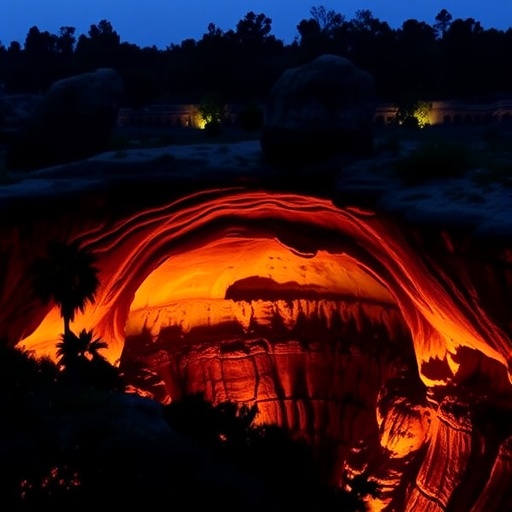In recent years, the concept of geoparks has gained remarkable attention across the globe as a pioneering approach to conserve geological heritage while fostering sustainable development and local community engagement. Particularly intriguing are the geoparks situated within karst landscapes, which present a unique confluence of complex geological formations, rich biodiversity, and intricate hydrological systems. In Brazil, a country renowned for its extensive karst regions dotted with caves, sinkholes, and subterranean rivers, the establishment and institutional management of geoparks represent both an opportunity and a challenge. New research sheds light on the evolving institutional frameworks and multilevel governance strategies that underpin these geoparks, revealing how diverse stakeholders collaborate to safeguard these precious natural assets.
Karst terrains emerge through the dissolution of soluble rocks like limestone and dolomite, sculpting terrain that is often visually stunning and ecologically critical. Brazilian karst areas, in particular, harbor one of the richest arrays of subterranean biodiversity globally, including unique cave ecosystems that support endemic fauna often adapted to complete darkness and nutrient scarcity. Beyond biodiversity, karst landscapes pose significant hydrogeological value as aquifers frequently act as major freshwater reservoirs. This dual ecological and economic significance marks Brazilian karst regions as deserving of carefully crafted conservation efforts integrated into regional development pathways.
The geopark model offers an innovative framework that transcends traditional conservation paradigms. It not only aims to preserve geodiversity but also leverages geological heritage for education, tourism, and community empowerment. Brazilian geoparks are often established within politically complex spaces where institutional arrangements involve a web of local authorities, federal agencies, indigenous communities, nongovernmental organizations, and private stakeholders. The latest investigations by Ruchkys and Auler systematically analyze these institutional scenarios, unpacking how governance mechanisms are constructed at multiple levels to sustain geopark objectives amid competing socio-political pressures.
One key insight emerging from this study is the crucial role of polycentric governance in Brazilian geopark management. Unlike centralized systems with top-down directives, polycentric governance features networks of autonomous yet interdependent actors working collaboratively within shared legal and institutional frameworks. This structure facilitates adaptive management tailored to the socio-environmental intricacies of karst regions, enabling responsive decision-making in the face of emerging challenges such as climate variability, tourism impact, and land-use conflicts.
Moreover, the research reveals that legal recognition of geoparks in Brazil remains a multifaceted process involving overlapping jurisdictional competencies. Federal environmental legislation interacts with state-level policies and municipal regulations, often generating regulatory ambiguities. Within this context, the participatory mechanisms embedded in geopark governance serve as essential arenas for negotiation and consensus-building among stakeholders. Such arrangements foster legitimacy and collective ownership of conservation strategies, which are critical for ensuring compliance and long-term sustainability.
Two emblematic examples reflect distinct governance paradigms in Brazilian karst geoparks. The first shows a scenario where governmental agencies spearhead conservation initiatives with an emphasis on scientific research and strict protection protocols. The second highlights more community-driven approaches that prioritize cultural heritage, eco-tourism, and local livelihoods alongside environmental stewardship. These case studies underscore how institutional diversity shapes the effectiveness and social relevance of geopark governance models.
Scientific investigations contribute substantially to these governance frameworks by providing updated geological mapping, biodiversity inventories, and hydrogeological assessments. These technical foundations underpin management plans that articulate zoning regulations, visitor infrastructure development, and environmental monitoring systems. The incorporation of cutting-edge technologies such as remote sensing, GIS, and environmental DNA sampling enhances the capacity for dynamic management and early detection of ecological threats.
However, challenges persist in balancing conservation goals with economic development imperatives. The inherent attraction of karst geoparks as tourist destinations raises concerns about environmental degradation through increased foot traffic, infrastructure expansion, and resource extraction pressures. Governance strategies therefore emphasize sustainable tourism paradigms that minimize ecological footprints while generating economic benefits for local populations. Capacity-building and environmental education programs play pivotal roles in sensitizing communities and visitors to the fragility and value of karst ecosystems.
Underlying successful geopark governance is the recognition of indigenous knowledge and cultural identity associated with karst landscapes. These territories have long been inhabited by traditional populations whose spiritual and historical ties to caves and rock formations enrich the socio-cultural significance of geoparks. Integrating indigenous perspectives not only strengthens social cohesion but also contributes to holistic conservation approaches that appreciate natural and cultural heritage as inseparable elements.
The research also discusses the importance of multilevel governance beyond territorial limits, since karst aquifers and ecological corridors often span administrative boundaries. Effective cooperation among municipalities, states, and even international partners is necessary to address transboundary environmental issues such as groundwater contamination and biodiversity connectivity. Framework agreements and joint management committees are emerging mechanisms facilitating this scale of coordination.
Financial sustainability remains a critical facet of geopark governance. The study highlights diverse funding sources, including governmental budgets, international grants, and public-private partnerships. Strategic resource allocation towards research, infrastructure, education, and community outreach ensures that geoparks not only preserve natural heritage but also foster resilient socio-economic systems. Transparency and accountability mechanisms embedded in governance structures aid in optimizing these financial flows.
Looking forward, the intersection of geoparks, karst science, and societal engagement heralds promising pathways for sustainable development in Brazil’s ecologically sensitive regions. The innovative multilevel governance strategies documented by Ruchkys and Auler contribute to conceptual frameworks adaptable to other karst landscapes worldwide. They illustrate that managing geological heritage is not solely a scientific endeavor but a multidimensional process involving institutional creativity, social participation, and environmental ethics.
Ultimately, the Brazilian example showcases how geoparks can function as integrative platforms that weave together conservation, culture, and development within the extraordinary realm of karst environments. As global environmental challenges intensify, the lessons drawn from these governance experiments resonate beyond national borders, inspiring new ways to harmonize humanity’s footprints with the planet’s geodynamic processes.
Subject of Research: Geoparks in Brazilian karst areas; institutional frameworks and multilevel governance strategies.
Article Title: Geoparks in Brazilian karst areas: institutional scenarios and multilevel governance strategies.
Article References:
Ruchkys, Ú.d.A., Auler, A.S. Geoparks in Brazilian karst areas: institutional scenarios and multilevel governance strategies. Environ Earth Sci 84, 437 (2025). https://doi.org/10.1007/s12665-025-12435-6
Image Credits: AI Generated




